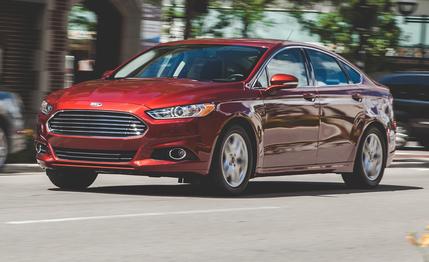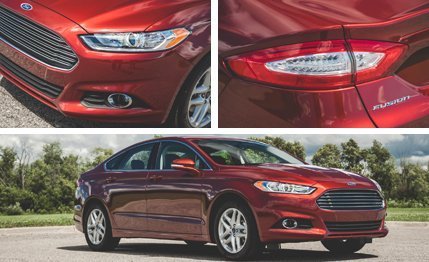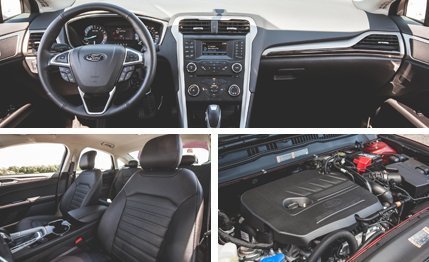 Instrumented Test
Instrumented Test
Unless you’re shopping for a used Ford Fusion, ignore our test of the 2013 model equipped with a 1.6-liter turbocharged four-cylinder EcoBoost engine. That engine won’t be installed in any Fusion after 2014, having been quietly replaced by the 1.5-liter EcoBoost four-cylinder, which is the focus of this test. So starting in 2015, the shuffle leaves the nonhybrid Fusion with three engine choices: a 2.5-liter four that comes with the S and SE; a 2.0-liter EcoBoost four that’s standard on the top-shelf Titanium trim and optional on the SE; and the SE’s available 1.5-liter EcoBoost.
So what happened to the 1.6L EcoBoost? When the 1.5L joined the 2.0L and 1.6L on the SE’s option sheet, it and the 2.0L were paired with automatic transmissions, while the 1.6L lost its automatic option and was restricted to the Fusion family’s lone manual (which is also gone for 2015). The move was designed to free up more 1.6 engines for the Escape; also, the 1.5L just so happens to slide the Fusion into a friendlier tax bracket in the Chinese market.
Happily, despite giving up 97 ccs (0.1 liter) of displacement to the old 1.6L, the 1.5L makes three additional horsepower and 1 more lb-ft of torque, for totals of 181 and 185. The only caveat is that the 1.5-liter’s peak horsepower and torque are produced higher in the rev range, meaning that the engine has to spin a bit faster to get there. That may help explain how the more powerful 1.5-liter Fusion ends up being 0.1 second slower to 60 mph—8.2 seconds total—and 0.1 second slower through the quarter mile—16.3 seconds at 85 mph—than the 1.6-liter Fusion, working through the same six-speed automatic transmission with an identical final-drive ratio, no less. Around town, there isn’t much gusto in the lower portions of the tach, but the 1.5-liter spins up in linear fashion and never feels overmatched.

Like the 1.6-liter it replaces, the 1.5 can be ordered with Ford’s engine stop-start system, and our test car had it. The $295 feature is rather agreeable, introducing no perceptible shake or untoward noise when re-firing the engine. It raises the EPA’s city and highway fuel-economy estimates by 2 and 1 mpg to 25 and 37 mpg (the old 1.6L with stop-start was rated for 24/37), and we averaged 27 mpg over 1086 miles. It’s certainly possible stop-start contributed to that figure, but more likely those fuel-economy numbers were boosted by the preponderance of highway cruising over the course of a 550-mile round-trip to Chicago. Regardless, in our hands the 1.6-liter averaged just 22 mpg, so chalk up a big win for the 1.5 EcoBoost.
The rest of the Fusion experience, which by and large is pleasant, with smart handling and a compliant ride, remains unchanged by the switch to the 1.5-liter. The smaller-displacement Fusion also mirrors its 1.6-liter forebear when it comes to stopping (it halted from 70 mph in the same 175 feet) and curiously trumps it around the skidpad (by 0.04 g) riding on the same tires, turning in a 0.84-g figure.
Time has yet to dull the sedan’s sultry, Aston Martin–like styling, but the passage of sand through the hourglass means you’ll encounter a lot of them out and about. The cabin continues to please with clean shapes, muted faux-wood touches, and soft-touch materials on the doors and dashboard.

Our SE test car arrived sans one critical option: Ford’s at-times-frustrating MyFord Touch infotainment system. This afforded us our first opportunity to try out a Fusion with the regular MyFord, non-touch-screen unit that still incorporates Ford’s Sync voice-control technology and is surrounded by—wait for it—actual hard buttons! Never mind that some of them are small and bizarrely clustered, and that visual navigation isn’t available; what matters is that simple tasks such as changing the radio station are far simpler and way less distracting than with MyFord Touch. Now you know.
The options fitted to our Fusion included the un-sexy-sounding $2050 Equipment Group 202A (leather seats and steering wheel, heated power front seats, fog lights, chrome trim, and auto-dimming rearview mirror), $295 backup sensors, $190 inflatable rear- seatbelt airbags, and the aforementioned $295 stop-start system. The 1.5L EcoBoost engine is a $795 charge. Tallying it all up returns an overall price tag of $27,890, quite the value proposition for the levels of quiet, subtle luxury, fuel economy, and style that the Fusion brings to the table.
Our verdict? The Fusion cedes only that extra tenth of driving engagement to our two mid-size favorites, the Mazda 6 and the Honda Accord, and its 1.5-liter EcoBoost engine cedes nothing to the one-tenth-of-a-liter-larger but ten-tenths dead 1.6 EcoBoost. That leaves those looking for refined mid-size transportation little to regret in choosing the Ford.